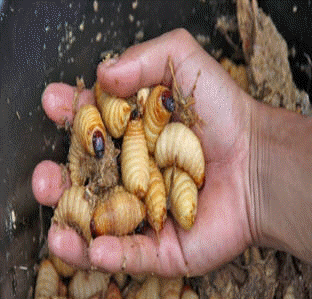
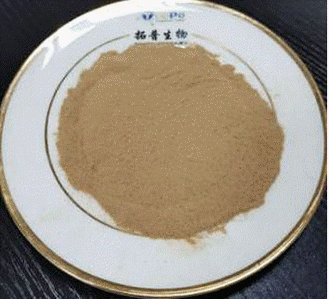
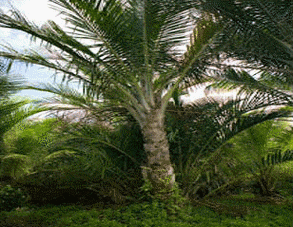
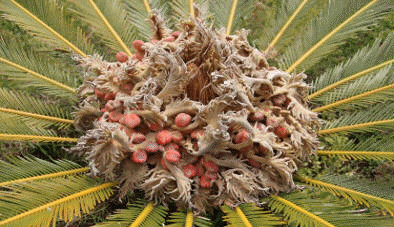
| Livestock Research for Rural Development 33 (7) 2021 | LRRD Search | LRRD Misssion | Guide for preparation of papers | LRRD Newsletter | Citation of this paper |
The purpose of this study was to determine the effect of substitution of fishmeal by Sago larvae meal (SLM) on the egg production and quality of laying hens. There were 5 treatments of fermented sago larvae replacing fish meal at 0, 15, 20, 25, and 40% of the diet, with each treatment replicated four times.
There were curvilinear increase in hen day production at 31-45 week and reduce feed egg ration as the proportion of SLM in diet was increased. The hen day production showed consistent optimum responses at the replacement level until 25%. But, there were no differences in egg quality traits among treatments both 19-30 week and 31-45 week. There is a growing interest in utilization of insect larvae meal for feeding poultry future trends.
Moreover, these insects could also help in solving some staple feed issues related to poultry farming such as fish meal.
Keywords: Borneo, Beetle, chitin, exoskeleton, protein
The world health organization (WHO) announced the novel corona virus (COVID-19) as a global pandemic outbreak since first quarter 2020 (Sjofjan et al 2021). The pandemic confirmed spread over the world included South East Asia countries like Indonesia as a development countries. Thus, condition made the newest regulation to inhibit spread the novel corona virus in feed production. The regulation was imposed a ban on the import of live animal species and imported fish meal originating from Tiongkok or transition into Indonesian territory. Indonesia imports large quantities of fishmeal (800 tonnes/year) (Sjofjan and Adli, 2020). If the feed production poultry reached 5 million tonnes / year in Indonesia, the fish meal needed was at 0.25-0.75 million tonnes of fish meal every year (Adli, 2020). Likewise, an important opportunity of animal nutrition were to develop using by-products as feed ingredients which would not otherwise be suitable for human nutrition. This procedure may reduce the cost of animal feeds as well as simultaneously contribute to environmental by utilizing these products. Indonesia has coastal line but still cannot produce fish meal as feed (Sjofjan and Adli, 2020). In line, the fish meal were identified as primary production use as feed in farming system. The used of the fish meal must be reduced and develop for alternative used as animal protein. Inside, the alternative of fish meal should not show negative effect like gizzard erosion on the animal.
In otherwise, the provision of feed for animals is a major contributor to land and water use greenhouse gas emission. In line, overfishing and reduction in available land and water resources in huge archipelago island like Indonesia on which crops can be grown has led to an increase in price of protein such as fish meal. Determination of novel solution meet the animal protein requirement balancing of production animals is key to development of animal industry in future trends. The European nation aim to develop production that efficiently uses such as feed and renewable energy. Invertebrates such as sago larvae meal are naturally behavior consumed by poultry, yet the large-scale production of insects for feed is yet to be exploited. Most insect are low producers of greenhouse effect and have low land and water requirement. Their habitat basically on the tree of forest country like Indonesia. The large-scale production of insect can contribute to a gross domestic product of country whereby feed waste are reduced or eliminated using bioconversion.
One of alternative to reduce used of fish meal were used insects as replacing protein source for animal protein. The proportion of fish meal about 5%-40% from total feed formulation.
Likewise, East Indonesia part were the biggest potential for producing the insect meal. Tara no ate, Moluccas, and Papua were three island in Indonesia which had Sago Palm tropical farm biggest in Indonesia. The total number of Sago Palm are on this Island occupies 1.40 million ha 80% (Sjofjan and Adli, 2021). The sago were a staple food for Indonesia eastern part where areas, the western part were rice as a food staple. The actual sago area in the Moluccas is 31.360 ha, and it can be developed to be about 649.938 ha. The number of sago trees ready to be harvested is counted 86 trees/ha (Sjofjan and Adli, 2021). In line the tropical condition made the Sago Palm area suitable to growth for coconut beetle ( Rhynchophorus ferrugineus) to lay egg. The coconut beetle produced the Sago larvae as protein potential in Indonesia. The breeding season occurred a yearlong and the larva could be harvested 39−45 days from post-cut away the tree. Based on the Agro ecological zone maps three area Toro no ate, Moluccas, and Papua had total area sago with scale 1: 250.000. Which is can be improve in the future (Adli, 2020).The sago larvae has not much chitin as other insect has it due to the exoskeleton don’t developed. Sago larva contains protein and energy, so it is prospective as a source of protein in feed to substitute fish meal.
 |
 |
| Photo 1. Live insect of Sago larvae | Photo 2. Sago Larvae Powder |
 |
 |
| Photo 3. Sago tree, which home of Sago Larvae | Photo 4. Sago Larvae feed |
The laying hens used in this study were 100 Lohmann-laying hens from 19 weeks until 30 as first phase weeks were reared, continued 31 until 45 weeks as second phase. The treatments were levels of 0, 15, 25, and 40% SLM replacing fish meal (Table 2). The laying hens were also given free access (ad libitum) to fresh water and feed throughout the study period twice a day at 07; 30 AM and 15; 30 PM. The laying hens were kept on a floor covered with litter and light was provided for 16 h per days.
The laying hens were weighed at the beginning of the experiment, and every week thereafter till the end of the week on the first phase (19-30 wk). Eggs were collected daily twice a day at 08; 00 and 16; 00 and weighed. The calculation of percentage of hen day egg production were as follows: (Hunton, 1995). The basal diet was prepared as a single feed and formulated (Table 2) to meet the nutrient requirements of laying hens (BSN, 2006). Feed intake, egg production, and feed conversion ratio (FCR) were recorded on weekly basis.
 |
Egg quality were measurement following standard procedures from Fayeye et al (2005).
Moreover, the egg quality measurement were egg weight (g), egg mass (g/hen/day), shell weight (g), shell thickness (mm), albumen weight (g), albumen height (mm), yolk weight (g), and haugh unit both phase 19-30 week and 31-45 week. The tripod were used to determine the albumen height (micrometre). Each phase the egg taken every day regularly in fresh condition then, each egg carefully opened to release the albumen and yolk. Then, between yolk and albumen were separated and placed in petri dishes glasses, which had initially been weighed.
The broken or abnormally condition in albumen and yolk such as red spot were recorded. Shell weight were weighed using electronic scale (g). The thickness of the egg measured by micrometre scrub. At the end, the haugh unit was calculated by using this formulae as follows (Haugh, 1937):
HU = 100 log (H+7.6-1.7W0.37)
Where,
Hu = Haugh unit,
H = observed height of the albumen in millimeter,
W = weight of egg in grams.
The materials used were sago larva worm in powder from Borneo Forest. The preparation step of making sago larvae meal (SLM) were following the (Sjofjan, and Adli, 2021). The larvae weight at collection ranged between 50 mg. The collected larvae were dried for 4 h in an oven at low temperature (60◦C) and grinded to a powder. The next step storing for 7 days at room temperature after which it was sun-dried (Sjofjan et al 2020). Before the digestibility trial representative sample of three samples from three island were analyses in Duplo, for dry matter (DM), crude protein (CP), fat for analyses of proximate and gross energy (GE).
|
Table 1. Chemical composition of the feed ingredients (% air-dry basis) |
|||||
|
DM |
CP |
CF |
Fat |
Chitin |
|
|
Maize |
87 |
8.2 |
3.4 |
7.2 |
- |
|
Fish meal |
86 |
34.5 |
4.5 |
5.5 |
- |
|
SLM |
88 |
35.2 |
3.5 |
3.1 |
0.11 |
|
Table 2. Ingredient composition of the laying hens diet |
|||||
|
Feed ingredient |
SLM replacing fishmeal, % |
||||
|
0 |
15 |
20 |
25 |
40 |
|
|
Maize (%) |
55 |
55 |
55 |
55 |
55 |
|
SLM (%) |
0 |
15 |
20 |
25 |
40 |
|
Fish meal (%) |
41 |
25.7 |
20.7 |
15.7 |
3 |
|
CaCO3 (%) |
1 |
1.1 |
1.1 |
1.1 |
1.1 |
|
Salt (%) |
0.3 |
0.3 |
0.3 |
0.3 |
0.3 |
|
Soybean oil (%) |
2.6 |
2.8 |
2.8 |
2.8 |
0.5 |
|
Vitamin premix (%) |
0.05 |
0.05 |
0.05 |
0.05 |
0.05 |
|
Mineral premix (%) |
0.05 |
0.05 |
0.05 |
0.05 |
0.05 |
|
1 per kg of diet: vitamin A 12,500 IU, vitamin D 32,500 IU, vitamin E 7.5 IU, vitamin K 2 mg, vitamin B1 2.5 mg, vitamin B2 4 mg, vitamin B6 1 mg, vitamin B12 0.012 mg; biotin 0.2 mg, folic acid 0.5 mg, vitamin C 50 mg, nicotinate acid 50 mg, Ca-D Pantothenate 4 mg, choline chloride 15 mg, copper 5 mg, iron 25 mg, iodine 0.2 mg, manganese 60 mg, selenium 0.2 mg, zinc 70 mg, cobalt 0.2 mg, zinc bacitracin 21 mg, lysine 160 mg, DL-methionine 50 mg, threonin 4 mg |
|||||
|
Table 3. Calculated analysis of the diets (%) |
|||||
|
SLM replacing fish meal, % |
|||||
|
0 |
10 |
20 |
25 |
40 |
|
|
DM |
91.4 |
91.3 |
90.2 |
92.3 |
91 |
|
CP |
18 |
18.2 |
18.2 |
18.3 |
18.4 |
|
Fat |
4.5 |
4.2 |
4.3 |
4.1 |
4.3 |
|
CF |
5..3 |
5.2 |
5.1 |
5 |
5 |
|
Calcium (%) |
2.48 |
2.48 |
2.48 |
2.47 |
2.48 |
|
Phosphorus (%) |
0.5 |
0.5 |
0.52 |
0.52 |
0.52 |
|
Lysine (%) |
1.3 |
1.3 |
1.3 |
1.3 |
1.3 |
|
Methionine (%) |
0.4 |
0.41 |
0.41 |
0.41 |
0.41 |
|
Dry matter (DM), crude protein (CP), crude fiber (CF) |
|||||
Data were subjected to analysis of variance using the general linear model program of the on Demand SAS software (online edition). Sources of variation in the model were treatments and error. Differences between treatment means were separated using Duncan’s multiple range tests. The following model was used. Yij = μ + Ti + eij, Where: Yij = represents the jth observation in the i th treatment level, μ = over all mean, Ti = treatment effect and eij = random error (Sjofjan et al 2021)
There were curvilinear increase in hen day production at 31-45 week and reduce feed egg ration as the proportion of SLM in diet was increased (Table 4). In line with Sjofjan and Adli (2021) were optimum at the level 25% replacement. The currently studies about SLM are rarely unknown. The previous study from Sjofjan and Adli (2021) the fermented sago larvae meal consisted crude protein 36.3% air-dry basis. Thus, paper the used of fermented sago larvae meal give optimum response until 25% replaced fish meal on the 35 days of broiler. The hen day production showed consistent optimum responses at the replacement level until 25% (table 4).
Compared with study from Mulyono et al (2021) the egg production decreased at the level 25% replacement, following with lower diet consumption. The egg production was affected by the feed consumed; the low consumption reduced production. The insect meal facing problem with the chitin as an exoskeleton component. The exoskeleton cannot digest by poultry. The chitin content in a fish meal were 0% and insect meal were 0.11%. In Southeast Asia, especially Indonesia fish meal is the major source protein used in the poultry diet formulation as feedstuff. Approximately fish meal used 20 g is consumed by hens to lay every single egg. But, national need for fish meal is around 150,000 tons/year and it can be fulfilled and available domestically only reaching 45,000/year (30%). The used of 30% must be divided into poultry and aquaculture sector. The majority of fish meal being used for this purpose originates from South America such as Peru and Chile. The imported fish meal also needed from China.
|
Table 4. Mean values for production fed increasing levels of SLM replacing fish meal |
||||||||
|
% SLM |
SEM |
p |
||||||
|
0 |
15 |
20 |
25 |
40 |
||||
|
19-30 wk |
||||||||
|
Feed intake (g) |
110 |
111 |
112 |
112 |
112 |
0.1 |
0.33 |
|
|
Initial weight (g) |
1201 |
1229 |
1211 |
1216 |
1218 |
0.3 |
0.21 |
|
|
Final body weight (g) |
1245 |
1253 |
1253 |
1256 |
1257 |
4.2 |
0.22 |
|
|
Egg weight (g) |
49.8 |
50.3 |
50.2 |
51.2 |
52.3 |
2.11 |
0.21 |
|
|
Egg mass (g/hen/day) |
20.5 |
20.4 |
20.3 |
20.3 |
20.1 |
1.33 |
0.21 |
|
|
Hen day production (%) |
42.2 |
42.3 |
41.2 |
43.2 |
41.3 |
2.33 |
0.2 |
|
|
Hen house production |
41.3 |
41.5 |
41.6 |
41.3 |
41.2 |
1.22 |
0.22 |
|
|
Fee egg ratio# |
5.44 |
5.22 |
4.88 |
4.82 |
4.83 |
0.76 |
0.11 |
|
|
31-45 wk |
||||||||
|
Feed intake (g) |
111 |
121 |
122 |
122 |
123 |
0.1 |
0.11 |
|
|
Final body weight (g) |
1322 |
1333 |
1333 |
1344 |
1332 |
2.2 |
0.15 |
|
|
Egg weight (g) |
50.1 |
49.3 |
48.3 |
49.4 |
49.1 |
1.11 |
0.12 |
|
|
Egg mass (g/hen/day) |
21.2 |
21.3 |
21.2 |
21.2 |
21.2 |
0.13 |
0.12 |
|
|
Hen day production (%) |
51.2 |
51.4 |
51.3 |
53.4 |
51.1 |
0.44 |
0.12 |
|
|
Hen house production |
50.3 |
50.2 |
50.6 |
50.3 |
50.2 |
0.16 |
0.13 |
|
|
Fee egg ratio# |
5.33 |
5.12 |
4.58 |
4.32 |
4.43 |
0.56 |
0.14 |
|
|
ab
Mean values in the same row without common superscript
differ at p<005
|
||||||||
Increasing fish meal plantations in these countries has been frequently associated with deforestation, which further translates into increasing threat to indigenous people and human right violations. Major drivers of fish meal-trade linked deforestation in Indonesia are: (1) increasing profit per hectare from fish-meal industries; (2) development of infrastructure for e.g., roads to facilitate fish meal transport; and (3) badly fabricated regulations. Addition from Aniebo et al (2008) there are four challenges that must be faced by the feed industry. Among other things, how to understand the nutritional specifications needed by farmed animals, match the characteristics of raw materials with these specifications, make good feed, and verify the feed through research and surveys in the field.
This scenario indicates the urgent need to find fish meal replacement. The sago larva meal are produced from the native forest in Indonesia, which is wide and huge. The sago larva meal could be grown as basis insect of alternative feed, later it was serving as an important pillar of circular economic in next 15 years futures. From the output of this study the used of fermented sago larvae meal (SLM) could be successfully used for the replacement of fish meal in Asia poultry diet without detrimental effects on production performance, behaviour of laying hens. Mali et al (2020) stated the fish meal that being processed as an animal protein dominate as the major sources of protein for poultry feed. But, the processed fish meal later were banned in Europe since it was indicated Transmissible Spongioform Encephalopathies (TSE) legislation, over exploitation of aquatic sources has drastically reduced the abundance of fish, while land available for cultivation of another protein resources has decreased due to the ever expanding human population
A slight average increase in final body weight was observed on 19-30 weeks of hens (Contrary to 31-45 week). However, there no significant differences in body weight between two phase of laying hens. For laying hens at this age, body weight gain has very little significance. Body weight gain is more significant for broiler industry, which could be a subject of future work, if compare with study from Sjofjan and Adli (2020). The sustainability side, thus insect meal (larvae basis) less conversion feed rate, meaning they need far less feed to produce than livestock animals such as chicken while the same amount of protein. Insect can also be grown on organic waste and emit fewer greenhouse rather than used fish meal as feed stuff.
|
Table 5. The effect of SLM replacing fish meal on egg quality parameters |
||||||||
|
% SLM |
SEM |
p |
||||||
|
0 |
15 |
20 |
25 |
40 |
||||
|
19-30 wk |
||||||||
|
Shell weight (g) |
4.67 |
4.66 |
4.66 |
4.66 |
4.66 |
3.2 |
0.22 |
|
|
Shell thickness (mm) |
0.31 |
0.33 |
0.31 |
0.34 |
0.33 |
1.8 |
0.12 |
|
|
Albumen weight (g) |
21.9 |
21.8 |
21.8 |
21.7 |
21.7 |
4.33 |
0.21 |
|
|
Albumen height (mm) |
3.22 |
3.65 |
3.65 |
3.66 |
3.75 |
6.23 |
0.12 |
|
|
Yolk weight(g) |
12.2 |
12.3 |
12.2 |
12.2 |
12.3 |
5.18 |
0.11 |
|
|
Haugh unit |
67.7 |
67.6 |
67.6 |
67.6 |
67.6 |
4.76 |
0.11 |
|
|
31-45 wk |
||||||||
|
Shell weight (g) |
4.88 |
4.87 |
4.88 |
4.88 |
4.88 |
0.1 |
0.23 |
|
|
Shell thickness (mm) |
0.44 |
0.43 |
0.42 |
0.41 |
0.44 |
2.2 |
0.21 |
|
|
Albumen weight (g) |
32.4 |
32.1 |
32.3 |
32.4 |
32.3 |
1.11 |
0.11 |
|
|
Albumen height (mm) |
21.2 |
21.3 |
21.2 |
21.2 |
21.2 |
0.13 |
0.14 |
|
|
Yolk weight(g) |
51.2 |
51.4 |
51.3 |
53.4 |
51.1 |
0.44 |
0.15 |
|
|
Haugh unit |
66.5 |
.66.4 |
66.6 |
66.3 |
66.6 |
0.16 |
0.17 |
|
|
ab Mean values in the same row without common superscript differ at p<005 |
||||||||
There were no differences in egg quality traits among treatments both 19-30 week and 31-45 week (Table 5). The egg quality parameters were unchanged with or without replacement of sago larvae meal in diets (Nginya et al 2019). A previous research from Mulyono et al (2021) on the insect meal did not showed significant effect. The research about the used of the insect are consistently rare unknown. A recently published report that the most popular among insect were used black soldier fly meal can improved the egg shell thickness comparison to a control. However, the consistently result there is no significance different among treatment observed.
A review article from Star et al (2020) only compiles literature related to inclusion of black soldier fly larvae meal in poultry feed. But, thus paper are not enough peer-reviewed literature studying the inclusion of insect larvae in poultry diets. It is expected that provision of insect larvae will not adversely effect on egg quality parameters. Another topics founded from investigated is the provisioning of live black soldier larvae in relation to the welfare of laying hens. The result were more challenging on the younger hens (Star et al 2020). Therefore, in the future it could be interesting to investigate the effect of increased live larvae on egg quality.
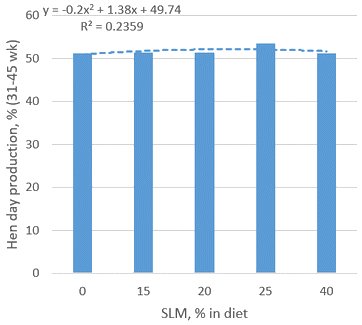 |
 |
| Figure 1. Effect of SLM on HDP, % (31-45 wk) | Figure 2. Effect of SLM on feed egg ratio (31-45 week) |
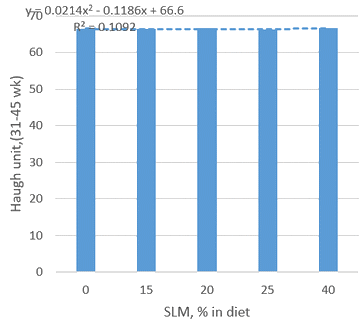 | |
| Figure 3. Effect of SLM on haugh unit (31-45 week) | |
We would like to thank all of those with whom we had the pleasure to work during this project.
Adli D N, Sjofjan O, Natsir M H, Nuningtyas Y F, Sholikah N and Marbun A C 2020 The effect of replacing maize with fermented palm kernel meal (FPKM) on broiler performance. Livestock Research for Rural Development. Volume 32, Article #120. http://www.lrrd.org/lrrd32/7/danung32120.html
Aniebo A O, Erondu E S, and Owen O J 2008 Proximate composition of housefly larvae (Musca domestica) meal generated from mixture of cattle blood and wheat bran. Volume 20, Article #205. Retrieved June 15, 2020, from http://www.lrrd.org/lrrd20/12/anie20205.htm
Bolton W 1967 Poultry Nutrition. MAFF Bulletin No.174, HMSO, London.
BSN (Indonesian National Standard) 2006 Standard for layer feed (SNI 01-3930-2006). National Standardization Agency of Indonesia, Jakarta, Indonesia (article in Bahasa).
Haugh R R 1937 The Haugh unit for measuring egg quality.US Egg and Poultry Magazine. 43:572-573.
Hunton P 1995 Egg production,processing and marketing.In:World Poultry Science, Elsevier, and Tokyo. Pp. 457- 480.
Kroeckel S, Harjes A G E, Roth I, Katz H, Wuertz S, Susenbeth A and Schulz C 2012 When a turbot catches a fly: evaluation of a pre-pupae meal of the black soldier fly (Hermetia Illucens) as fish meal substitute — growth performance and chitin degradation in Juvenile Turbot ( Psetta Maxima). Aquaculture 364-365 (October): 345 52. https://www.researchgate.net/publication/234080829_When_a_turbot_catches_a_fly_Evaluation_of_a_pre-pupae_meal_of_the_Black_Soldier_Fly_Hermetia_illucens_as_fish_meal_substitute_-_Growth_performance_and_chitin_degradation_in_juvenile_turbot_Psetta_maxi
Mali B, Okello S, Ocaido M and Nalule A S 2020 Optimal inclusion level of termite meal replacing fish meal in broiler diets. Livestock Research for Rural Development. Volume 32, Article #169. Retrieved June 9, 2021, from http://www.lrrd.org/lrrd32/11/b3mal32169.html
Mulyono M, Widiyanto W, Mangisah I, Krismiyanto L, Yunianto V D, Ismadi B, Sukamto B, Wahyono F and Suthama N 2021 The substitution of fish meal with larvae of Hermetia illucens supplemented with Trichoderma sp on quail's nutritional utility and egg production. Livestock Research for Rural Development . Volume 33, Article #37. Retrieved June 9, 2021, from http://www.lrrd.org/lrrd33/3/qmuly3337.html
Nginya E S, Ondiek J O, King’ori A M, and Nduko J M 2019 Evaluation of grasshoppers as a protein source for improved indigenous chicken growers. Livestock Research for Rural Development . Volume 31, Article #2. Retrieved June 15, 2020, from http://www.lrrd.org/lrrd31/1/shilo31002.html
Sjofjan O, Adli D N, Djunaidi I, and Kuncoro K 2020 Utilization of Biogas Liquid Waste For Starter In The Fermentation of Rice Husk As A Potential Feed For Poultry. Animal Production. Volume 22, Article #1. Retrieved June 15, 2020, from http://103.30.145.38/index.php/JAP/article/view/38
Sjofjan O, Adli D N, Harahap R P, Jayanegara A, Utama D T, and Seruni A P 2021 The effects of lactic acid bacteria and yeasts as probiotics on the growth performance, relative organ weight, blood parameters, and immune responses of broiler: A meta-analysis. F1000Research, Volume 10, Article # 183. Retrieved June 9, 2021, from https://f1000research.com/articles/10-183
Sjofjan O, Adli D N, Sholikin M M, Jayanegara A, and Irawan A 2021 The effects of probiotics on the performance, egg quality and blood parameters of laying hens: A meta-analysis. Journal of Animal and Feed Sciences, Volume 30, Article #1. Retrieved June 9, 2021, from http://www.jafs.com.pl/The-effects-of-probiotics-on-the-performance-egg-quality-and-blood-parameters-of,133432,0,2.html
Sjofjan O and Adli D N 2021 The effect of replacing fish meal with fermented sago larvae (FSL) on broiler performance. Livestock Research for Rural Development . Volume 33, Article #17. Retrieved June 9, 2021, from http://www.lrrd.org/lrrd33/2/danun3317.html
Sjofjan O, Adli D N, Natsir M H, Nuningtyas Y F, Bastomi I and Amalia F R 2021 The effect of increasing levels of palm kernel meal containing α-β-mannanase replacing maize to growing-finishing hybrid duck on growth performance, nutrient digestibility, carcass trait, and VFA. Journal of the Indonesian Tropical Animal Agriculture, Volume 46, Article #1. Retrieved June9, 2021, from https://www.cabdirect.org/cabdirect/abstract/20210056478
Sjofjan O, Adli D N, Natsir M H, Nuningtyas Y F, Wardani T S, Sholichatunnisa I, Ulpah S N, Firmansyah O 2021 Effect of Dietary Modified-Banana-Tuber Meal (M-BTM) Substituting Dietary Corn on Growth Performance, Carcass Trait and Dietary-Nutrients Digestibility of Coloured-Feather Hybrid Duck (Pekin x Khaki Campbell Ducks). Jurnal Ilmu Ternak dan Veteriner, Volume 26, Article#1. Retrieved June9, 2021, from http://medpub.litbang.pertanian.go.id/index.php/jitv/article/view/2686
Star L, Arsiwalla T, Molist F, Leushuis R, Dalim,M, and Paul A 2020 Gradual provision of live Black soldier fly (Hermetia illucens) larvae to older laying hens: Effect on production performance, egg quality, feather condition and behavior. Animals, Volume 10, Article #2. Retrieved June 9, 2021, from https://www.mdpi.com/2076-2615/10/2/216